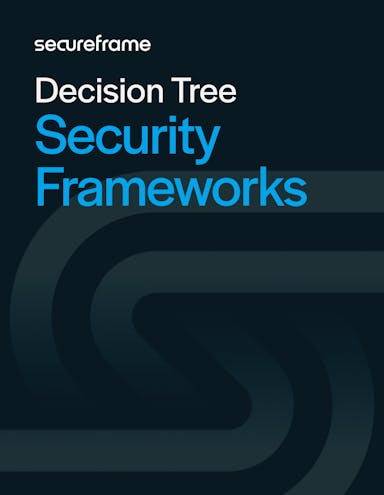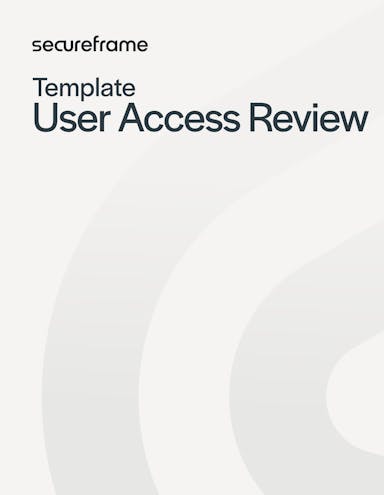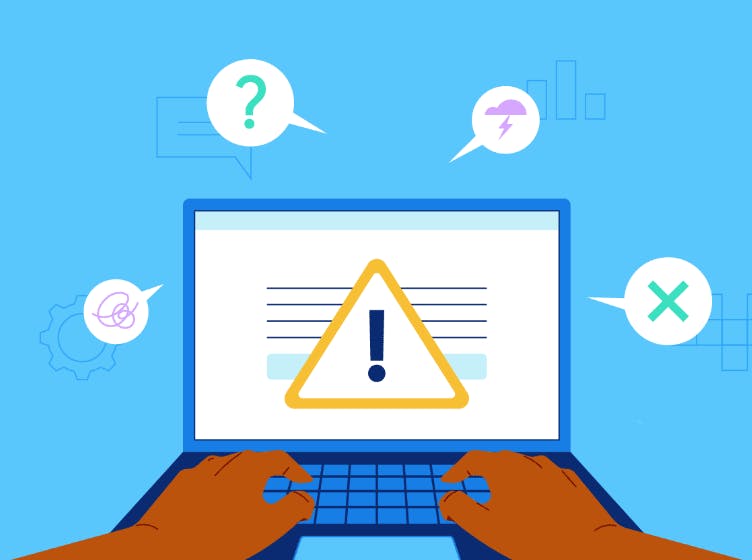If your organization is about to complete an extensive compliance audit, that’s a huge accomplishment. But you may be wondering if checking the compliance box is enough to protect your organization against growing threats.
While getting certified in all the necessary security frameworks is an important milestone, becoming a secure organization requires you to go further.
Security compliance encompasses everything an organization does to protect company assets and meet security and compliance standards and regulations.
In this post, we break down security and compliance. We then walk through how these two efforts go hand-in-hand to create a robust security strategy.
What is IT security?
Information technology (IT) security refers to the efforts made to protect an organization’s assets and clients. It’s about safety and self-preservation, not obedience to meet a third party’s contractual or regulatory requirements.
IT security programs aim to:
- Prevent attacks against their organization’s digital and physical infrastructure and data
- Quickly respond to security incidents to limit the harm done
It’s important to note that security isn’t a one-and-done process.
While security efforts are being continuously improved, hackers are also getting more sophisticated. A commitment to security means regular monitoring and updating.
A few areas of IT security to focus your efforts on include:
- Access controls: This focuses on verifying the identity of users and ensuring they have the appropriate level of access to resources.
- Penetration testing: Pen testing refers to the use of third parties to launch attacks on an organization’s security systems to test their resilience.
- Incident response and forensic analysis: This process scans for threats, probes software to locate malware, and deciphers hacker activity to defend against future threats. It also collects evidence to bring to trial.
Before we go further, let’s clarify how IT security relates to terms that are often used interchangeably.

IT security vs cybersecurity
IT security broadly refers to the efforts made to protect an organization’s digital infrastructure, network endpoints, including laptops and mobile devices, and the data they contain. IT security encompasses all digital and physical security issues — from malicious cyber attacks to improper system configurations to faulty hardware components to insecure server areas. It also involves responsibilities like risk management, security training, and continuous monitoring, which help protect data and information systems from unauthorized access.
Cybersecurity is a subset of IT security. It refers to the efforts made to protect computer systems, networks, devices, applications, and the data they contain from digital attacks only.
IT security vs information security
Information security (InfoSec) is another subset of IT security. Where IT security encompasses protecting data as well as computers, networks, physical data centers, cloud services, and other organizational assets, InfoSec is solely focused on data protection and data privacy. It refers to the efforts made to protect the confidentiality, integrity, and availability of sensitive business information in any form, including print or electronic.
Implementing strong IT security practices, including cybersecurity and InfoSec practices, can help keep your organizational assets safe — but it’s only one part of a comprehensive security strategy. Let’s take a closer look at the other part below.
What is IT compliance?
Information technology (IT) compliance refers to the protective measures an organization puts in place to appease a third party, whether that be the government, industry, certification body, or clients.
Common third-party requirements include:
- Government policies
- Security frameworks
- Industry regulations
- Client or customer contractual terms

If you fail to comply with mandated frameworks and regulations, you’ll be penalized. This often takes the form of hefty fines, which is why many organizations drop everything to prepare for audits.
Let’s take a look at an incident that reflects the danger of non-compliance.
In 2018, a cyber attack on British Airways exposed the personal and financial details of over 400,000 customers.
An investigation determined that the company should have identified and resolved security gaps. As a result, the Information Commissioner’s Office (ICO) slapped the company with a £20 million fine.
If the compliance risk example above made you cringe, you’re not alone. Failing to comply with mandated security frameworks like GDPR, CCPA, HIPAA, and PCI DSS can not only damage your reputation. It can also be incredibly costly.
Unfortunately, compliance regulations are often difficult to understand and attain for non-IT professionals. A comprehensive GRC strategy can help.

Security frameworks decision tree
Use this series of questions to help select the best security framework(s) based on your or your clients' industry, data, and needs.
IT Compliance and GRC
IT compliance is hugely important to any security program and to an overarching GRC strategy.
GRC stands for governance, risk, and compliance. Often, security professionals will specialize in all three areas. Let’s break them down:
- Governance: This is the operations stage. Establishing business goals and monitoring progress toward them are essential components of governance.
- Risk: GRC experts must identify potential security risks, and control them wherever possible.
- Compliance: In addition to managing business goals and asset protection, GRC experts must ensure that the organization adheres to regulatory guidelines and industry standards.
IT security vs. IT compliance
Compliance does not equal security. An organization may comply with all governmental and industry-wide regulations and still be vulnerable to cyber threats.
Let’s take a look at what sets security and compliance apart from one another.

IT security and IT compliance do have common goals and overlap in many ways.
Here are a few of their similarities:
- Both reduce risk: Compliance provides base-level security measures demanded by your industry or by the government. Security-mindedness fills in remaining security gaps, further minimizing risk of being compromised.
- Both improve reputation: Vendors and customers alike want organizations to protect their data. Together, compliance certifications and robust security policies signal that your organization will take good care of its stakeholders.
- Both apply to third parties: Many security frameworks expect the organization itself and its vendors to comply. Likewise, security measures aren’t just put in place to protect the organization itself. They also protect partners.
That said, IT security and IT compliance are not one and the same.
Here are some of their key differences:
- Enforcement: A third-party regulator enforces compliance with a set of standards. Security tends to be practiced by an organization for its own benefit.
- Core motivation: The primary motivation for compliance efforts is penalty avoidance. Nobody wants to be slapped with a massive fine. Security measures are implemented to protect an organization’s precious assets. This includes data, money, and intellectual property.
- Evolution: Compliance is relatively static. While updates to frameworks do happen, they’re not being updated every day as new threats emerge. Security measures, on the other hand, change alongside the evolution of threats.
How security and compliance come together
The key takeaway is that security and compliance are two sides of the same coin.
Although compliance is mandated by a third party, it serves a practical security purpose: to provide a standard to keep an organization safe from cyber threats.
Codifying security practices can help identify and patch gaps in existing security measures. Becoming compliant also signals to stakeholders that you’re a reliable partner who will keep their data safe.
That said, compliance tends to only meet the base-level security demands of an industry.
True confidence in a security program requires you to implement additional security measures. Every organization has different vulnerabilities and assets to protect. But there are some proven practices to consider as you develop your own program.

Why is security compliance important?
Security compliance offers an organization several benefits. Let’s take a look at five of these benefits.
1. Fine and penalty avoidance
No matter your location or your industry, it’s critical to research which compliance laws apply to your organization.
If you collect customer data — whether that be credit card information, website cookies, or personal identifying information — there are regulations you should adhere to.
It’s not just the U.S. that’s cracking down on compliance. Europe’s GDPR is known as one of the strictest regulations, with the ICO fining organizations up to €20 million for GDPR violations.
Implementing a comprehensive security compliance program can help you avoid fines and penalties.
2. Security breach prevention
Your data is precious. Certain industries like healthcare and finance hold particularly sensitive information, and are more vulnerable.
In 2025, healthcare data breaches had the highest average breach cost for the 14th consecutive year at $ 7.42 million.
Of course, organizations in any industry can fall victim to a costly attack. As long as you have data stored in your systems, cyber criminals have an incentive to strike.
Strong security and compliance measures can deter them from attacking your organization.
3. Reputation enhancement
It’s no mystery what a massive security breach can do to a company’s reputation.
The 2013 attack on Yahoo — when hackers stole data from 3 billion users’ accounts — caused irreparable damage to the brand’s reputation. The company had to notify all of its users that their data was compromised. The event also made global news and is still viewed as a massive cybersecurity failure.
Security breaches imply that an organization is not committed to protecting its users’ data. Repairing trust is painstaking work and is not guaranteed.
When news can spread across the world in a matter of minutes, security compliance must be taken seriously to maintain the trust of vendors, clients, and customers.
4. Thorough data management practices
Under GDPR, your organization could be contacted by the ICO and told to provide the exact whereabouts of a user’s data. Failure to comply will subject you to massive fines or even more significant legal penalties.
While more of a “stick” than a “carrot” approach, this pressure encourages excellent data management practices.
To comply and avoid a penalty, you’ll want to keep tabs on all of your users’ data. This will likely require improved data organization methods and upgraded tools.
While it may feel like a hassle initially, improving these practices will help streamline your processes. Better organization of user data may even shed light on new marketing opportunities.
5. Positive internal and external relations
An organizational commitment to all aspects of security is attractive to employees and third parties alike.
Going beyond legal compliance and making security a core part of your organizational identity has two major benefits. It communicates that you respect your customers and value integrity.
This will open the door to partnerships with organizations that also value security, which diminishes risk and ultimately puts you in good company.
Recommended reading

130+ Compliance Statistics & Trends to Know for 2026
Read MoreHow to practice good security compliance
It’s clear why security compliance is key for success, but how do you do it correctly? Below, we discuss nine best practices to help you strengthen your IT security program.
1. Conduct an internal security audit
An internal security audit can help a company understand how effective its current security strategy is and identify and mitigate potential threats. For example, a company may discover that it’s using outdated software or a new technology that’s introduced vulnerabilities.
Unlike a formal certification audit, an internal audit is usually a voluntary review of a company’s own security infrastructure. Conducting them regularly can help expedite external audits and make them less stressful.
2. Create a compliance plan that spans departments
Regulatory frameworks explain what protections organizations must have in place. But they often don’t describe exactly how to implement them. This depends on an organization’s operations and resources.
Before implementing a security compliance program, align with HR, IT, compliance, and upper management to make a plan. This plan should include which standards you’re expected to comply with and how you plan to achieve compliance.
Refer to our guides for SOC 2 and ISO 27001 compliance as you begin crafting a plan that’s right for your organization.
3. Monitor continuously
Sometimes, security threats can feel far-removed. It's tempting to only monitor what’s dictated by compliance regulations. However, failing to monitor for real threats thoroughly makes an organization a prime target for cyber criminals.
After conducting a risk assessment, use any vulnerabilities as a map to guide your ongoing security efforts.
4. Use audit logs
Undergoing audits is often a compliance requirement for certain security frameworks. Using audit logs is a security compliance best practice that can make those audits more meaningful and help ensure records are maintained of any system activity.
As a refresher, audit logs are records of activity history within an IT system.
These provide documentation to prove compliance with industry regulations. When monitored internally, audit logs can also identify suspicious activity and improve security.
5. Configure systems using least privilege and least functionality
The principles of least privilege and least functionality state that users and programs should only be granted essential privileges.
This standard should be applied across nearly every industry as a risk prevention measure.
As employees move into more senior roles, it’s important to strike a balance between granting more advanced permissions and still protecting the channels that hackers could infiltrate.
Admittedly, finding this balance isn’t always easy. Employees may need to pause their work and request additional system permissions every once in a while.
But these minor efficiency hiccups are worth it. Least privilege and least functionality will help keep hackers and malware out of critical files and processes.
6. Regularly perform user access reviews
A user access review, UAR for short, refers to the periodic review of the credentials and privileges of users who can access certain data, applications, and networks in order to remove any unnecessary and inappropriate privileges and/or individuals with credentials.
UARs reduce the risk of data breaches and cybersecurity incidents tied to unauthorized access and reduce data exposure to only what is required, which can mitigate the impact of a breach if it does occur.

Download our free user access review template
Ready to implement user access reviews at your organization? Use the template below to kick off the process.
7. Segregate duties and system functions
Teamwork is essential to accomplish most organizational processes. This holds especially true for security management.
To segregate duties and system functions, core processes are split into individual tasks. Each of these tasks must be completed by a different person.
For example, you could provide widely accessible credentials to send an announcement to a company’s shareholders. But that wouldn't be very secure.
Instead, a member of the IT department could hold the login credentials. The CEO could then draft the message. An administrator could proofread and approve it. And the IT professional could ultimately press send.
Delegating each step of a key process to a different person significantly reduces the chances of a cyber criminal infiltrating the system and wreaking havoc.
8. Update all company software frequently
Cyber criminals notoriously target companies that use outdated software. New threats are always emerging, and they are most common in software that hasn’t been updated to the latest version.
Stay on top of patches so that you can remain compliant and keep your assets safe.
9. Implement a strong risk management plan
A compliance plan is critical for meeting industry standards. But how do you prepare your individual organization for an attack? You create a risk management plan.
This plan should detail what your organization’s existing vulnerabilities are, how to identify risks, and a recovery process for when breaches do happen. This is a crucial step in improving your organization’s security posture.
Despite the prevalence of cyber attacks, over 77% of organizations do not have a cybersecurity incident response plan applied consistently across the enterprise. If any of these organizations suffer a large-scale attack, they’re in big trouble.
Once your plan is in place, you should test it to determine its resilience — and learn from it. Be sure to take care of any vulnerabilities you identify.
10. Utilize intelligent and automated tools
Security compliance can be challenging, time-consuming work. With so many bases to cover, occasional mistakes and moments of negligence are difficult to avoid.
Automating your compliance process with the right tools can help prevent these human errors. Compliance automation tools are designed to streamline, simplify, or cut down on some of the manual work in the compliance process, particularly around workflows, reports, and documentation. This can save tens of thousands of dollars and months of your security team and compliance team’s time.
Recommended reading

11 Tips to Effectively Reduce Human Errors in the Workplace
Read MoreIs security compliance enough?
Compliance is an important part of any IT security program, but it’s only one part of the equation.
A note from a Verizon Data Breach Report sums it up:
“While compliance definitely helps drive security, compliance does not equal security.”
Internal security safeguards — such as regular monitoring, software updates, automated tools, and duty segregation — are paramount to crafting a robust and resilient security program because they are based on preventing, managing, and mitigating risk and not meeting compliance standards alone.
How Secureframe can streamline your security compliance efforts
Without help from experts, practicing security compliance can be a long and taxing process.
Significant time must be put into implementing regulatory frameworks and other security measures. Those efforts also need to be continuously monitored to ensure sustainable security.
Secureframe makes security compliance a breeze by automating the process from start to finish.
Of course, we don’t only handle implementation. We consolidate audit and risk data and information, including vulnerabilities from cloud resources, and conduct continuous monitoring to look for gaps in controls so you can maintain continuous compliance.
As you enter new partnerships with common vendors, our software can retrieve their security information on your behalf and provide detailed vendor risk reports to speed up vendor evaluations. You’ll never have to enter another business relationship wondering whether your assets may be compromised.
Want to learn more about how Secureframe can play an integral part in developing a robust security compliance program? Request a demo of our platform today.